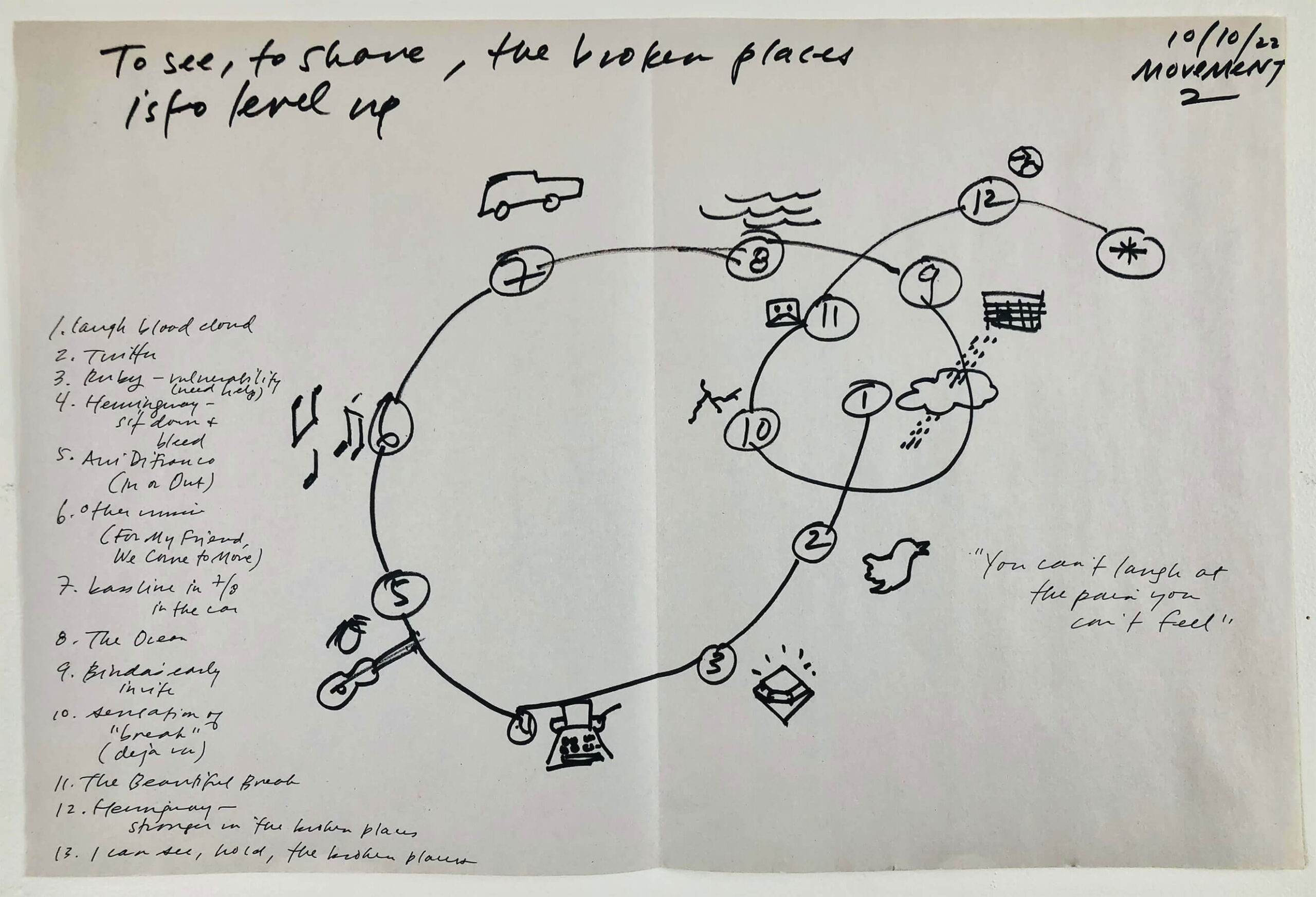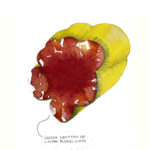response
Jenny

I was so struck by Binda’s drawings/paintings of the “laugh blood cloud” and the vampire comedian watering the audience with blood — seemed like a very appropriate illustration of any standup, not just vampire standup. I read a tweet the next day that said, “You can’t laugh at the pain you can’t feel,” which seemed like a perfect lyric to me. I got in touch with a musician friend of mine, Ruby, who suggested that the song was really about shared vulnerability. This reminded me of Ernest Hemingway‘s famous quote, “Writing is easy. All you do is sit down at a typewriter and bleed.” With this in mind, I started writing. My first take on “Bleed With Me” was in the style of Ani DiFranco, which you can hear in the recording of Iteration 1:
The way I sang the first line — “Bleed with me, baby; come to me and break” — reminded me of something. Since Helices is all about the intertwining of influences, I set my mind the task of figuring out what it was. Eventually I did remember: It was one of my own songs, “The Beautiful Break,” written long ago for a songwriting contest (the assignment: write a song about one of the Seven Deadly Sins). My body remembered the similar articulation of the hard “K” at the end of the word “break.” It comes at the very end of the song:
I wasn’t quite satisfied with my Ani DiFranco version of “Bleed With Me,” though, so I started listening to a bunch of other music to inoculate myself with other sounds and ideas. (This is a very common way for me to work when songwriting.) I recorded a bassline in the car and then later that night in rehearsal:
And then THAT reminded me of the Led Zeppelin song “The Ocean”:
I liked a lot of what I had done musically in these early versions, but none of them was really a vehicle for vulnerability in the way I wanted it to be; they felt hard rather than soft. So I started experimenting with the song in a different direction. I haven’t made a great (or complete) recording of it yet, but this gives a sense:
Bleed With Me, Baby
Bleed with me, baby
though I’m frightened by it
I’ve been aching to
finally break in two
won’t you help me try it
Bleed with me, baby
Come and spill your need
Let the openness
of our brokenness
finally set us free
Come and bleed with me
and I don’t need you to promise
that you’ll stay forevermore
or even love me
I just want to find someone
who is not afraid to feel
or, better, who’s afraid and feels anyway —
Bleed with me baby
let’s not turn away
what if there could be pleasure in letting the pain finally have its say
Bleed with me, baby
Let’s not stop it now
We can pull off the bandage, examine the damage, and let it spill out
I don’t really believe in a past life
but some of these scars seem too ancient
to be only mine
at the same time, I’m bruised
like I got beaten up just yesterday
I’m not healing
I’m lying in a pool of my feelings
come on and bleed with me
Bleed with me, baby
though I’m frightened by it
I’ve been aching to
finally break in two
with you here, I think I can try it
Bleed with me, baby
Come and spill your need
May the openness
of our brokenness
be how both of us
finally get free
Come on and bleed
yeah bleed
with me
The process helped me feel into another one of Hemingway’s quotes: “The world breaks everyone and afterward many are strong at the broken places.” It seemed clear to me that sharing your broken places — through song, through writing, through standup — is a way to level up. You might look as if you’re in the same place on the circle, but if you shift your perspective to look from the side, you’re actually making a spiral.
